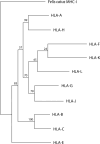Evolution and molecular interactions of major histocompatibility complex (MHC)-G, -E and -F genes
- PMID: 35925520
- PMCID: PMC9352621
- DOI: 10.1007/s00018-022-04491-z
Evolution and molecular interactions of major histocompatibility complex (MHC)-G, -E and -F genes
Abstract
Classical HLA (Human Leukocyte Antigen) is the Major Histocompatibility Complex (MHC) in man. HLA genes and disease association has been studied at least since 1967 and no firm pathogenic mechanisms have been established yet. HLA-G immune modulation gene (and also -E and -F) are starting the same arduous way: statistics and allele association are the trending subjects with the same few results obtained by HLA classical genes, i.e., no pathogenesis may be discovered after many years of a great amount of researchers' effort. Thus, we believe that it is necessary to follow different research methodologies: (1) to approach this problem, based on how evolution has worked maintaining together a cluster of immune-related genes (the MHC) in a relatively short chromosome area since amniotes to human at least, i.e., immune regulatory genes (MHC-G, -E and -F), adaptive immune classical class I and II genes, non-adaptive immune genes like (C2, C4 and Bf) (2); in addition to using new in vitro models which explain pathogenetics of HLA and disease associations. In fact, this evolution may be quite reliably studied during about 40 million years by analyzing the evolution of MHC-G, -E, -F, and their receptors (KIR-killer-cell immunoglobulin-like receptor, NKG2-natural killer group 2-, or TCR-T-cell receptor-among others) in the primate evolutionary lineage, where orthology of these molecules is apparently established, although cladistic studies show that MHC-G and MHC-B genes are the ancestral class I genes, and that New World apes MHC-G is paralogous and not orthologous to all other apes and man MHC-G genes. In the present review, we outline past and possible future research topics: co-evolution of adaptive MHC classical (class I and II), non-adaptive (i.e., complement) and modulation (i.e., non-classical class I) immune genes may imply that the study of full or part of MHC haplotypes involving several loci/alleles instead of single alleles is important for uncovering HLA and disease pathogenesis. It would mainly apply to starting research on HLA-G extended haplotypes and disease association and not only using single HLA-G genetic markers.
Keywords: Apes; Complotypes; Disease; Evolution; HLA; HLA-E; HLA-F; HLA-G; Haplotypes; MHC; Monkeys.
© 2022. The Author(s).
Conflict of interest statement
The authors declare no relevant competing interests to disclose.
Figures






Similar articles
-
Two different complement Factor B (Bf) alleles of the orangutan major histocompatibility complex (MHC) are also conserved in chimpanzee and humans showing importance in primate immunity.Mol Biol Rep. 2024 Nov 21;52(1):6. doi: 10.1007/s11033-024-10086-7. Mol Biol Rep. 2024. PMID: 39570459
-
Major histocompatibility complex complement (MHC) Bf alleles show trans species evolution between man and chimpanzee.Sci Rep. 2023 Oct 4;13(1):16711. doi: 10.1038/s41598-023-42016-1. Sci Rep. 2023. PMID: 37794053 Free PMC article.
-
Evolution of major histocompatibility complex G and C and natural killer receptors in primates.Hum Immunol. 2009 Dec;70(12):1035-40. doi: 10.1016/j.humimm.2009.07.017. Epub 2009 Aug 6. Hum Immunol. 2009. PMID: 19651181 Review.
-
Human MHC class III (Bf, C2, C4) genes and GLO: their association with other HLA antigens and extended haplotypes in the Spanish population.Tissue Antigens. 1988 Jan;31(1):14-25. doi: 10.1111/j.1399-0039.1988.tb02060.x. Tissue Antigens. 1988. PMID: 3341017
-
Two to Tango: Co-evolution of Hominid Natural Killer Cell Receptors and MHC.Front Immunol. 2019 Feb 19;10:177. doi: 10.3389/fimmu.2019.00177. eCollection 2019. Front Immunol. 2019. PMID: 30837985 Free PMC article. Review.
Cited by
-
The role of non-classical and chain-related human leukocyte antigen polymorphisms in laryngeal squamous cell carcinoma.Mol Biol Rep. 2023 Sep;50(9):7245-7252. doi: 10.1007/s11033-023-08629-5. Epub 2023 Jul 7. Mol Biol Rep. 2023. PMID: 37418079
-
The MHC (Major Histocmpatibility Complex) Exceptional Molecules of Birds and Their Relationship to Diseases.Int J Mol Sci. 2025 Apr 16;26(8):3767. doi: 10.3390/ijms26083767. Int J Mol Sci. 2025. PMID: 40332403 Free PMC article. Review.
-
Long-read single-cell sequencing reveals expressions of hypermutation clusters of isoforms in human liver cancer cells.Elife. 2024 Jan 11;12:RP87607. doi: 10.7554/eLife.87607. Elife. 2024. PMID: 38206124 Free PMC article.
-
Prevailing Antagonistic Risks in Pleiotropic Associations with Alzheimer's Disease and Diabetes.J Alzheimers Dis. 2023;94(3):1121-1132. doi: 10.3233/JAD-230397. J Alzheimers Dis. 2023. PMID: 37355909 Free PMC article.
-
Challenges of CRISPR/Cas-Based Cell Therapy for Type 1 Diabetes: How Not to Engineer a "Trojan Horse".Int J Mol Sci. 2023 Dec 10;24(24):17320. doi: 10.3390/ijms242417320. Int J Mol Sci. 2023. PMID: 38139149 Free PMC article. Review.
References
Publication types
MeSH terms
Substances
Grants and funding
LinkOut - more resources
Full Text Sources
Molecular Biology Databases
Research Materials
Miscellaneous

